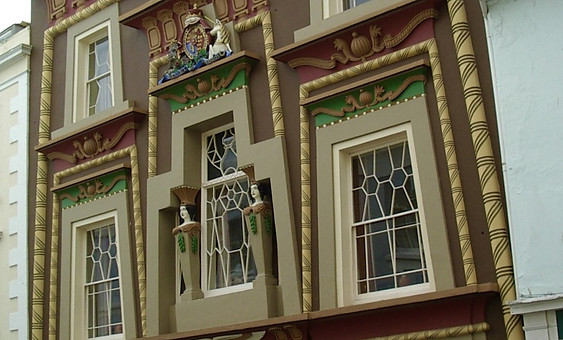TOP 12
Here is a list of my 12 current favourite places in Cornwall.

01
OS map 102: JUBILEE POOL, Penzance.
Built in 1935, the art-deco style Jubilee Pool continues to defy the Atlantic gales. It is a beautiful period piece which has been lovingly preserved. On hot summer days a refreshing dip in this magnificent, triangular-shaped lido is not to be missed. For added fun and excitement dogs are allowed in the pool on the last day of the season.

02
OS map 103: MOST SOUTHERLEY POINT, Lizard.
The Hottentot Fig runs riot down the cliffs at the Most Southerly Point. Introduced from South Africa this thug of a plant has a nasty habit of strangulating all other plants that should have the temerity to get in its way. The National Trust prevents its spread along the cliffs but at the Most Southerly Point it is given free rein, and it has to be said, to spectacular effect.

03
OS map 104: HOLY WELL, Holywell Bay
Like no other Holy Well in Cornwall this natural cave in the cliff at Holywell Bay is a sensation. Only accessible at low tide the red, green, white and purple rocks are startling. At the top of the steps is a naturally formed ‘well-house’ which you can crawl into. It is like entering the underworld.

04
OS map 105: CAERHAYS CASTLE GARDEN, East Porthholland.
Caerhays was built in 1813 by John Nash and has an arresting presence. However, it is the 100-acre garden, planted by J.C. Williams on the sloping hills behind the house, that is of particular interest. It has an exceptional collection of magnolias that begin to flower in early spring and can be seen clearly poking their colourful noses out amongst the native trees.

05
OS map 106: THE RUMPS IRON AGE PROMONTORY FORT, Polzeath.
The dragon disappearing into the sea in the distance is the Iron Age Fort. This dramatic peninsula of rock is defended by a series of ramparts at its neck and would have been almost impenetrable. The splendid view inspired Lawrence Binyon to compose the poem ‘For the Fallen’ in 1914 as recorded in the plaque at the forefront to the photo.

06
OS map 107: LERRYN, north of Fowey.
Lerryn is a tranquil village at the head of Lerryn Creek, a tributary of the River Fowey.
Kenneth Grahame, author of The Wind in the Willows, would row from Fowey to Lerryn where it is thought the nearby Ethy House was his inspiration for Toad Hall. To the south of the river are the remains of Tivoli Park. The stepping-stones are uncovered at low tide and are fun to cross.

07
OS map 108: ST GERMANS CHURCH, St Germans.
St Germans Church was the Anglo-Saxon Cathedral of Cornwall. Today’s church only dates from Norman times and between the two flanking towers of the west front is the formidable recessed doorway of seven orders, the best in Cornwall. Adjacent to the church is Port Eliot House, which was built on part of the old priory, and more recently has been the venue for mud larking, poetry and much else for one weekend in the summer.

08
OS map 109: BUTTERN HILL BURIAL MOUND CIST, Bowithick Bridge.
To reach the top of Buttern Hill you must climb 1,125 feet from Bowithick Bridge, picking your way through some substantial tin streaming works on the way. At the summit is a magnificent Bronze Age burial mound cist, the best preserved on Bodmin Moor. In the distance can be seen Roughtor. (A cist is a stone-built burial-box). This is one of the places you get a deep sense of Cornwall's long history.

09
OS map 112: LAUNCESTON STEAM RAILWAY, Launceston.
The 2-foot gauge track runs for 2½ miles along the old route of the London and South Western Railway which connected Waterloo to Padstow and operated from 1899 to 1966. Always optimistic, the L&SWR called it ‘Atlantic Coast Express.’ Today the puffing steam, black smuts and rocking carriages will satisfy all those with a nostalgia for steam, and their grandchildren too.
_JPG.jpg)
10
OS map 106: CORNISH HURLING, St Columb Major.
Cornish Hurling was first recorded in 1584. Two teams of any number of men from adjacent parishes scrum for a silver ball engraved: TOWN AND COUNTRY DO YOUR BEST. With no apparent rules the aim of the game is to take the ball over the parish boundary. It is played hard and furiously for many hours with many injuries.

11
OS map 102: THE EAST TERRACE, St Michael Mount's garden.
Situated on the more sheltered part of the island, on either side of the walled garden, are the West
and East Terraces. Built in the 1880s uneven steps that twist and turn take you from one narrow terrace to the next. The flowers are grouped by colour such as yellow, bronze and orange with the slivery granite of the castle serving as a backdrop.

12
OS map 102: THE EGYPTIAN HOUSE, Penzance.
Built in 1836, at the top of Chapel Street in Penzance, the Egyptian House stands out because of its strikingly ornate façade. Of particular interest are the lotus bud
columns on either side of the doorway, the windows with their array of geometric glazing bars and the corded pilasters painted light and dark brown. An unexpected and rewarding visual treat.